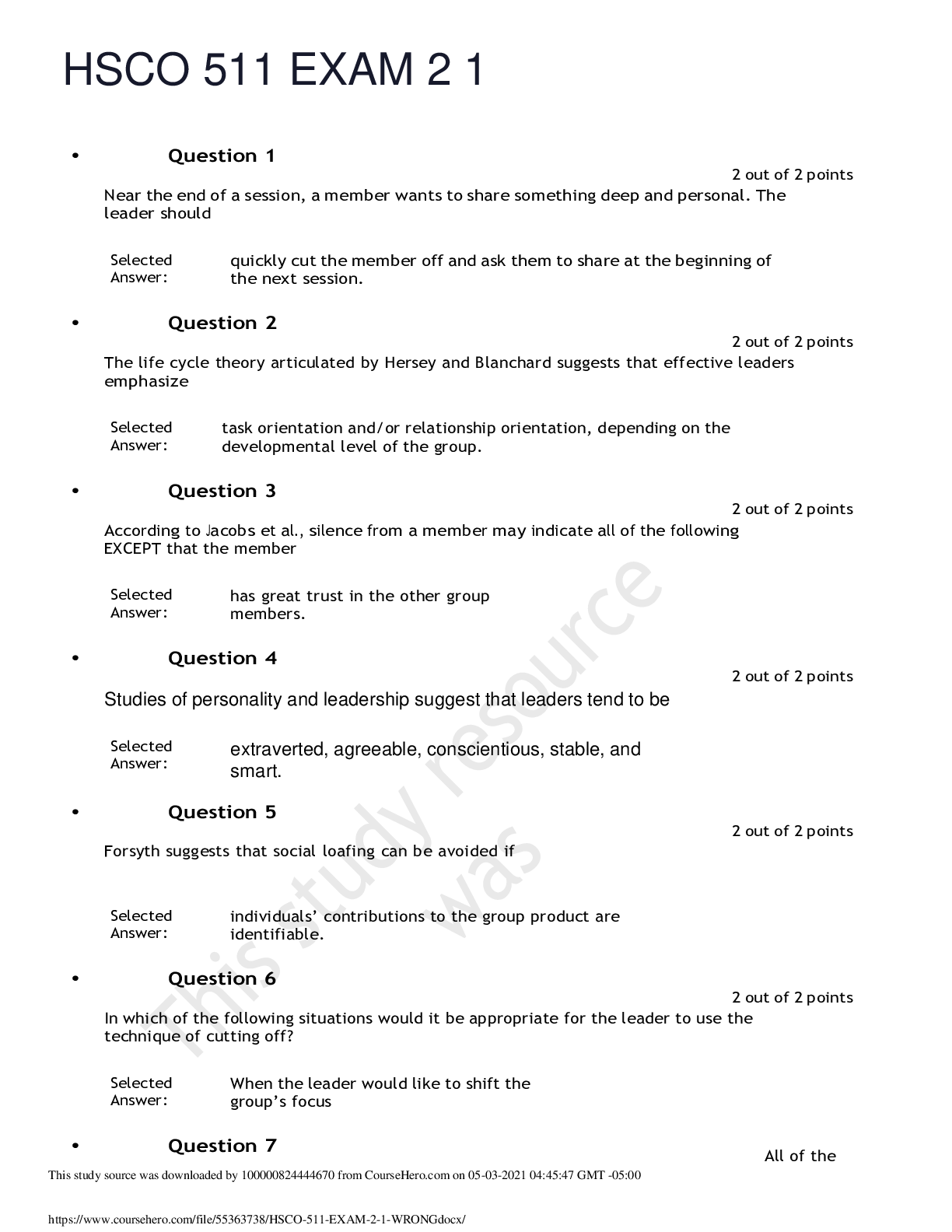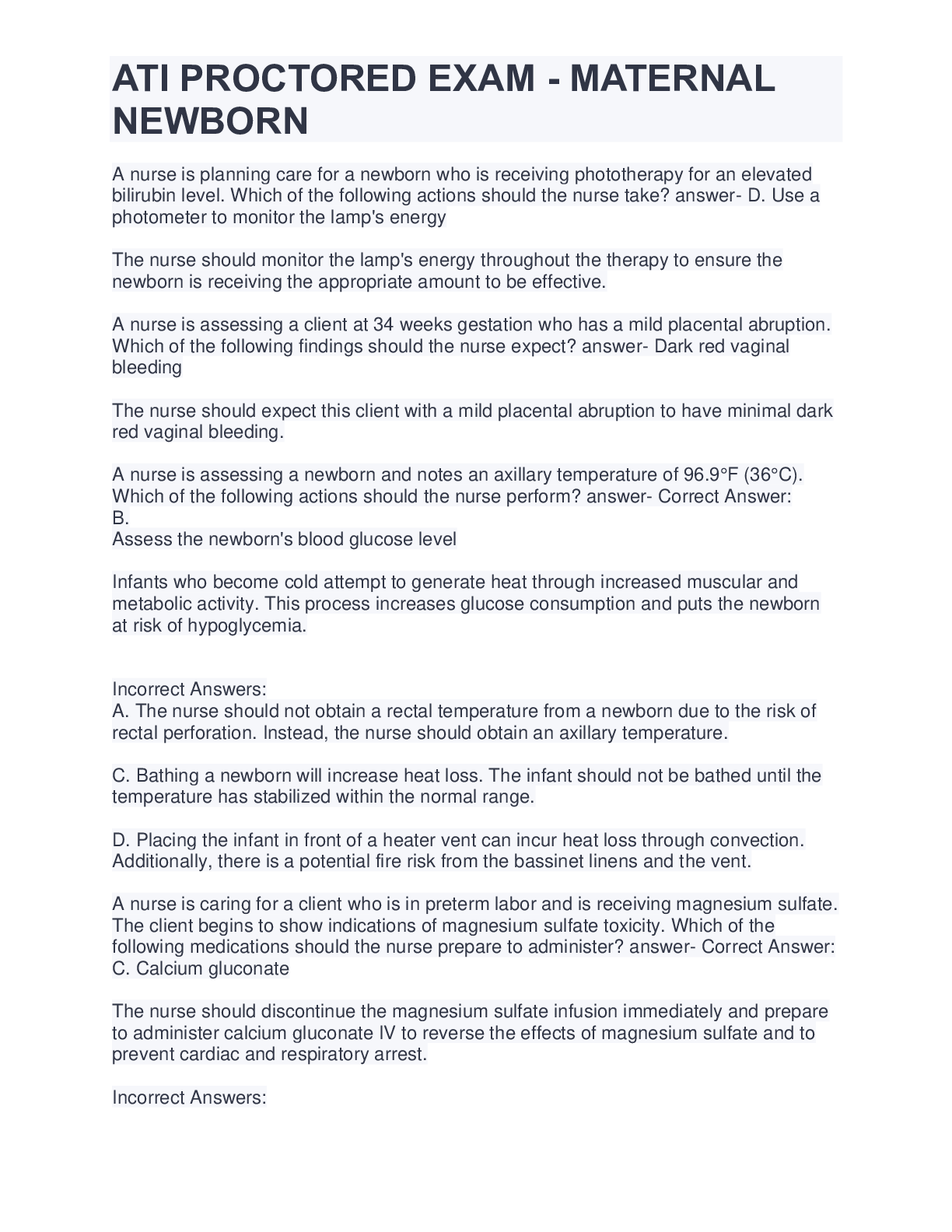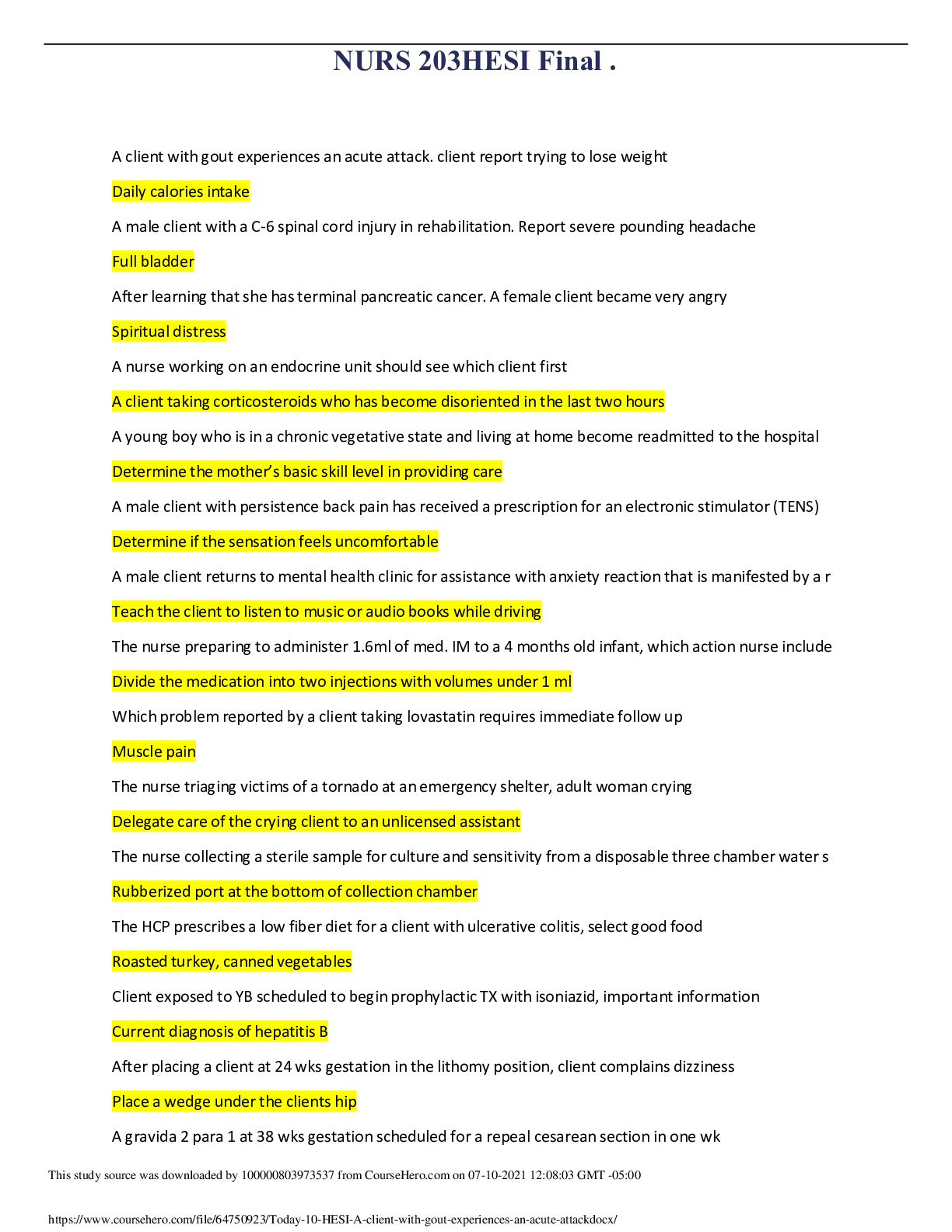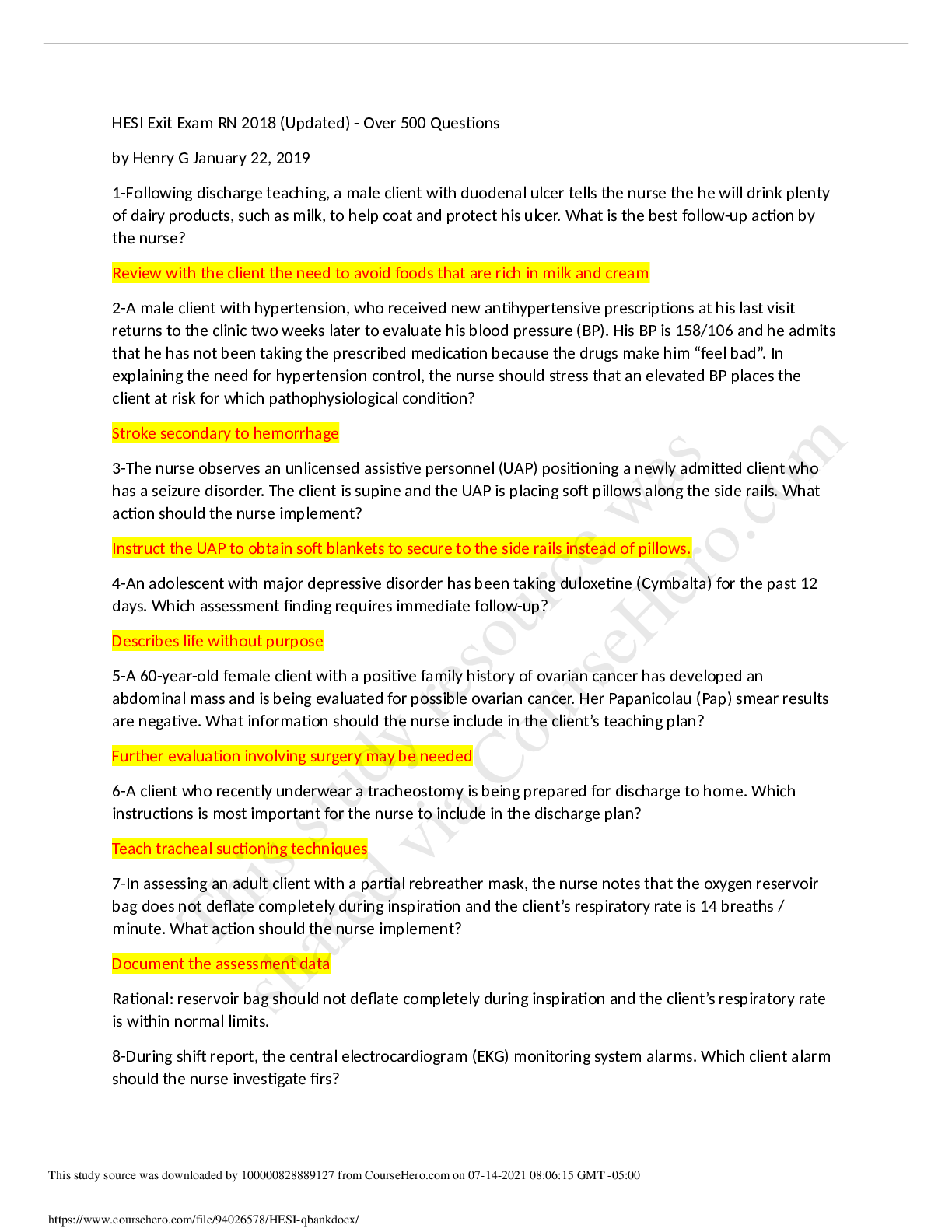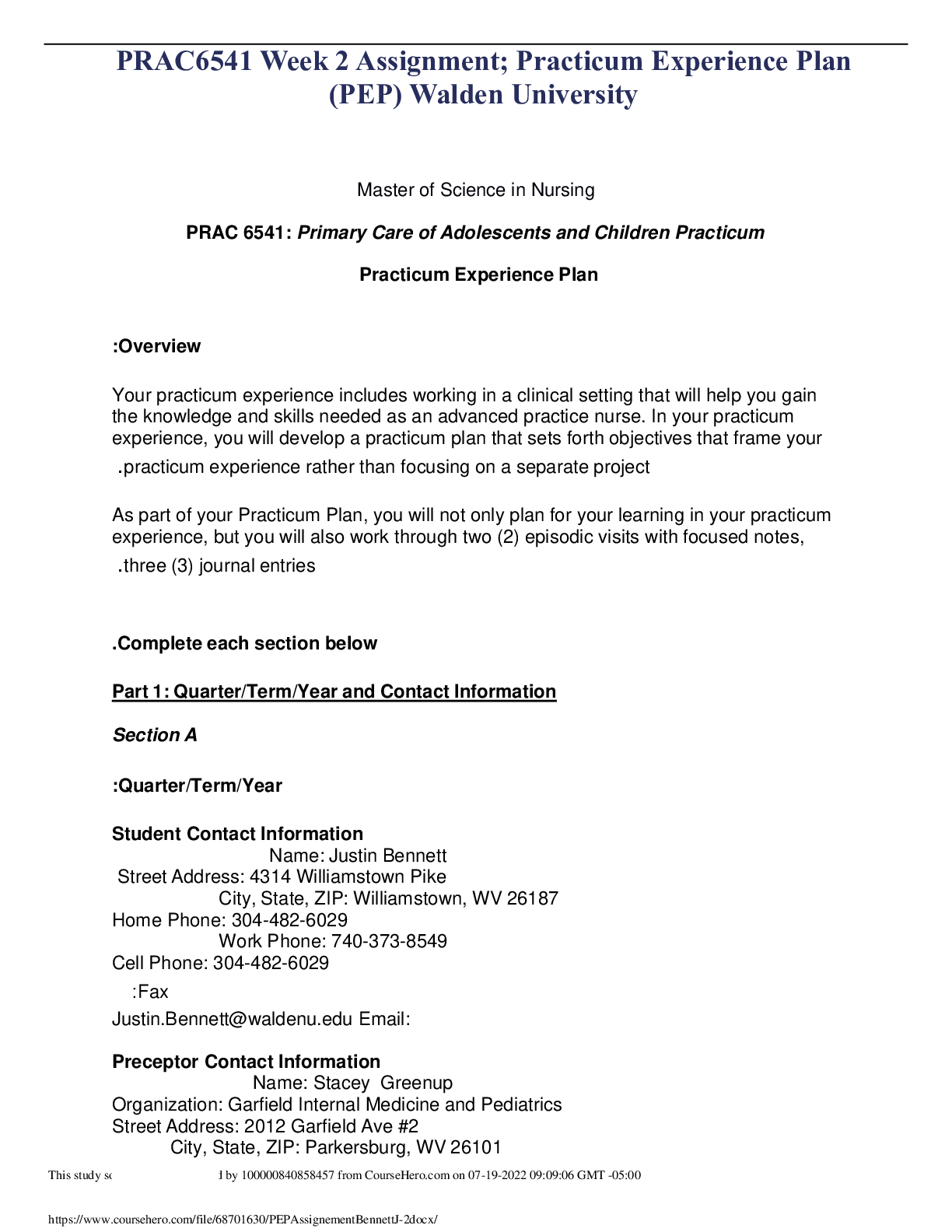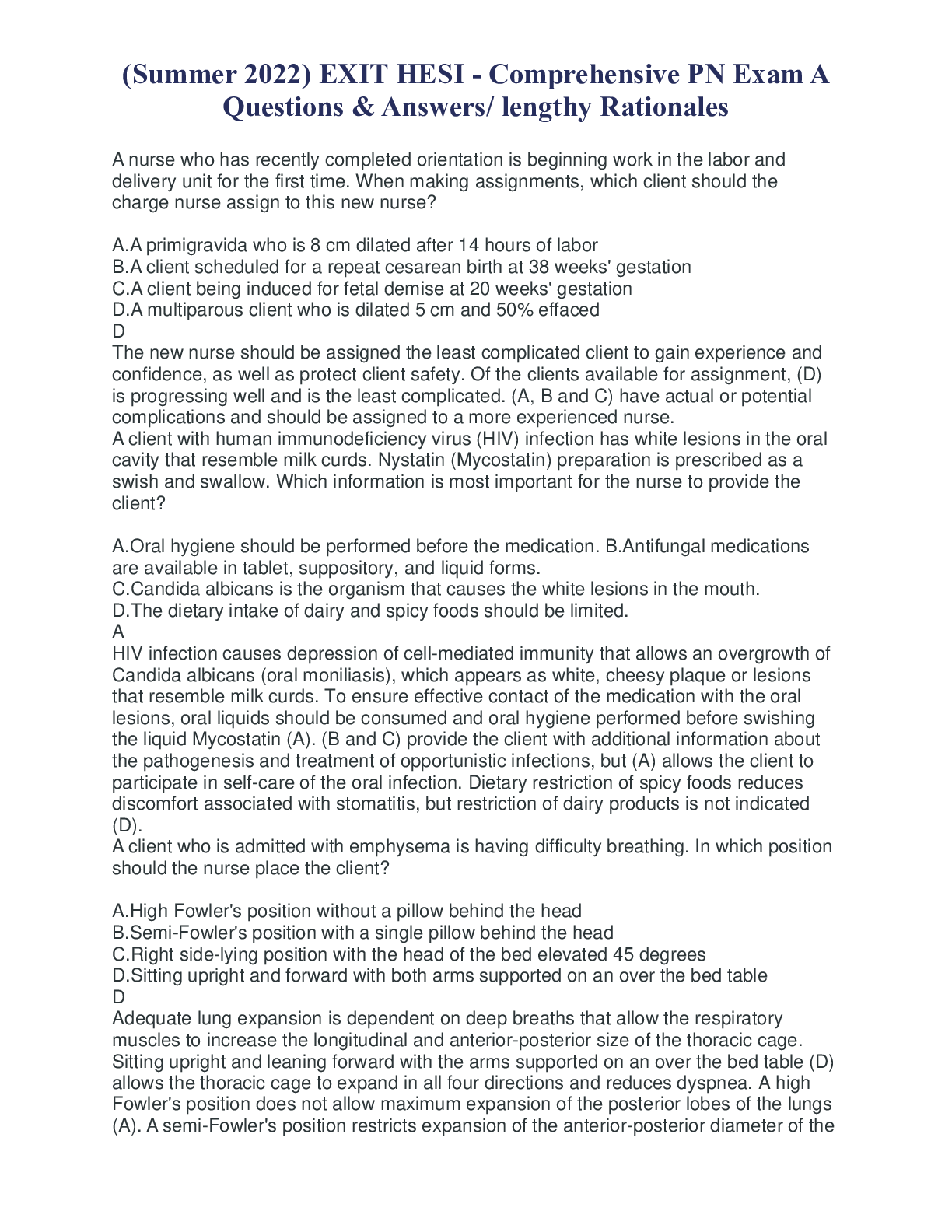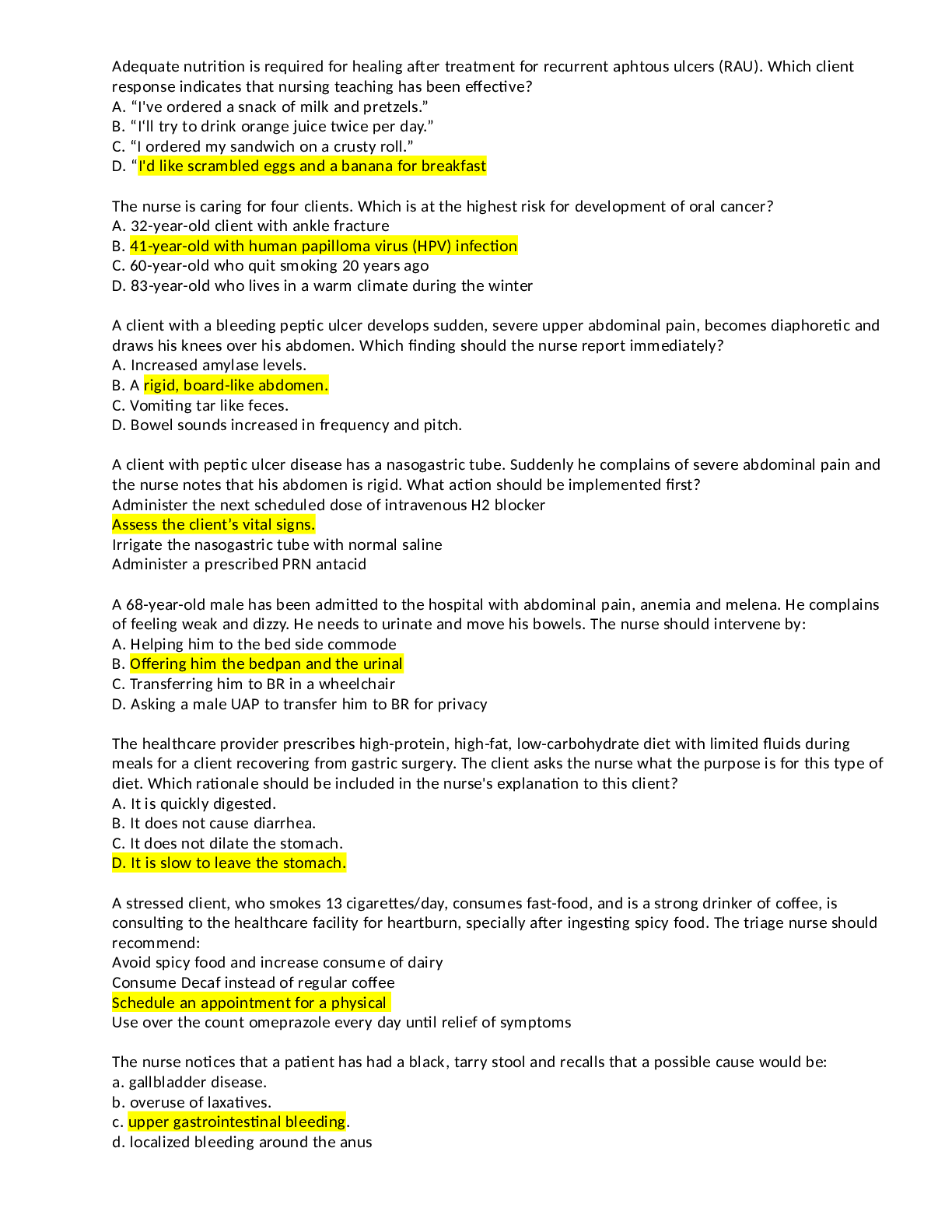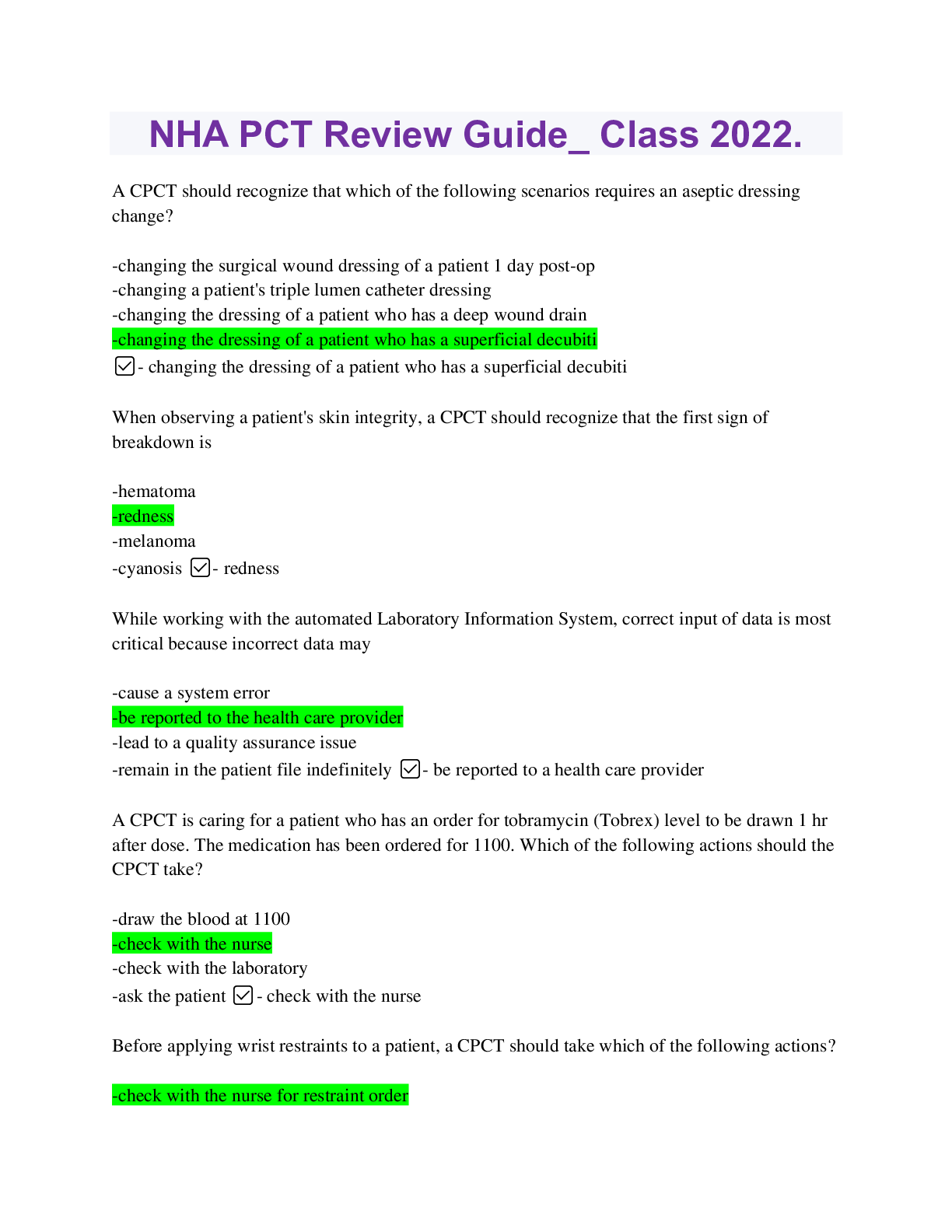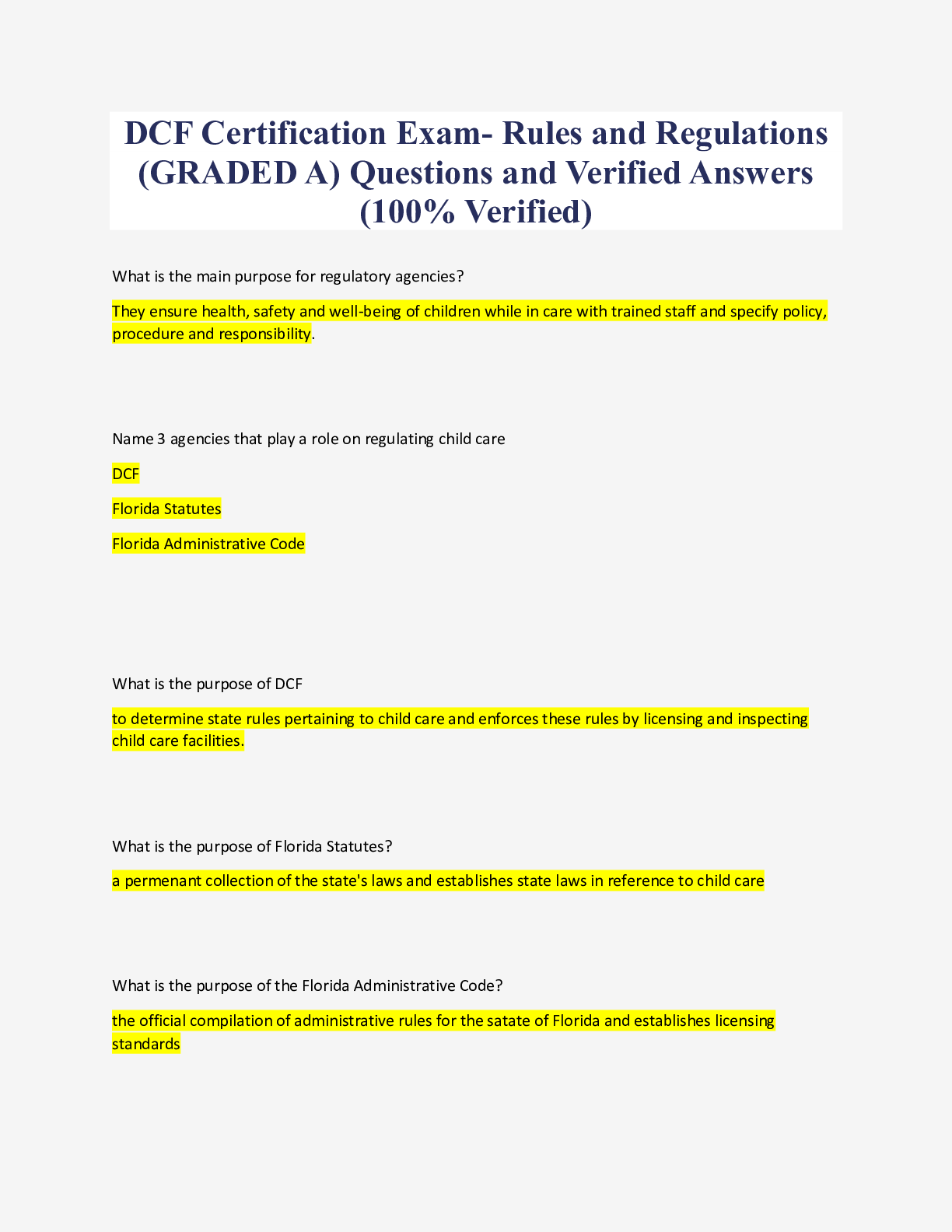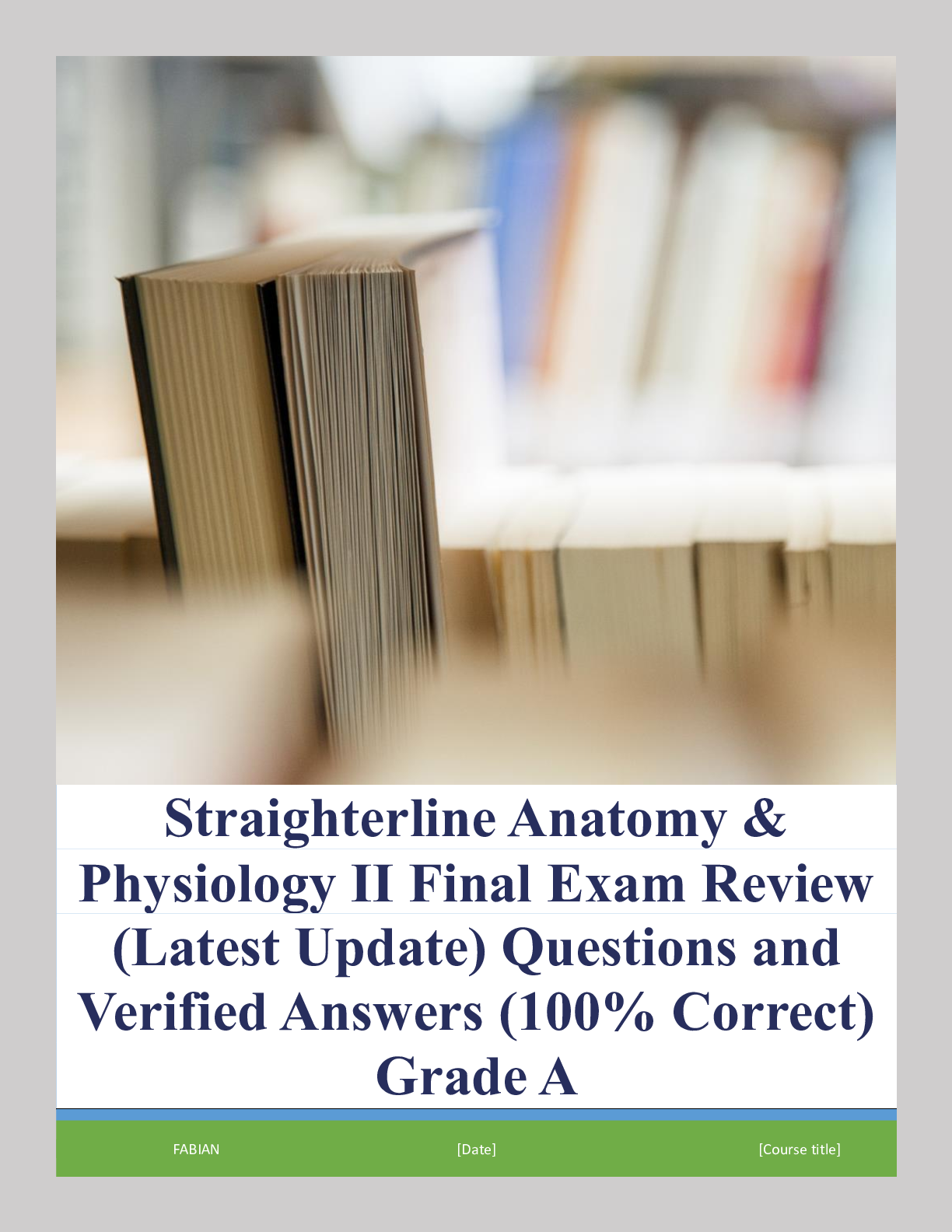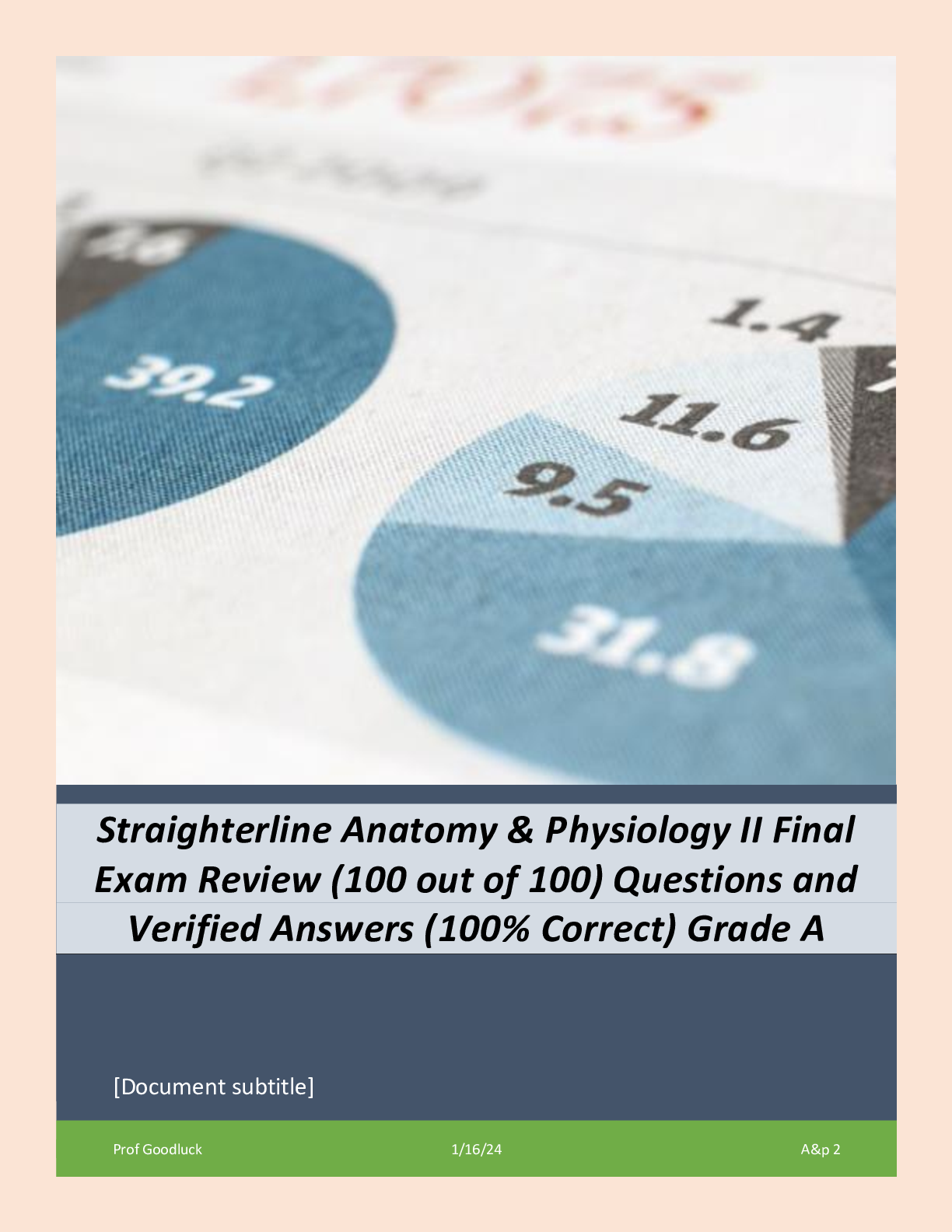*NURSING > EXAM > SEJPME II Module Tests Test Bank from Module 2 to 22, Latest 2019/20 Guide. Verified Answers (100% A (All)
SEJPME II Module Tests Test Bank from Module 2 to 22, Latest 2019/20 Guide. Verified Answers (100% A+)
Document Content and Description Below
MODULE 2 1) _____ is a violent struggle among state and non-state actors for legitimacy and influence over the relevant population(s). It favors indirect and asymmetric approaches, though it may emplo... y the full range of military and other capacities, in order to erode an adversary's power, influence, and will. [objective51] Asymmetric warfare Traditional war Joint warfare Irregular warfare 2) The President of the U.S. provides guidance for developing, applying, and coordinating the instruments of national power to achieve objectives that contribute to national security in the _____. [objective52] National Defense Strategy National Security Strategy Unified Command Plan National Military Strategy 3) The _____ is written guidance from the Secretary of Defense to the Chairman of the Joint Chiefs of Staff for the preparation and review of contingency plans for specific missions. It includes the relative priority of the plans, specific force levels, and supporting resource levels. [objective53] Unified Command Plan Guidance for Employment of the Force Joint Strategic Capabilities Plan National Defense Plan 4) The statutory advisers to the National Security Council are the _____. [objective54] National Security Advisor and the Economic AdvisorDirector of National Intelligence and the Chairman of the Joint Chiefs of Staff Secretary of Homeland Security and the Chairman of the Joint Chiefs of Staff Director of Central Intelligence and the Attorney General 5) The operational chain of command runs directly from the President to the Secretary of Defense and then to the _____. [objective55] Chairman of the Joint Chiefs of Staff Chairman of the Joint Chiefs of Staff and then to the Combatant Commanders Combatant Commanders Service Chiefs 6) The four categories of support are _____. [objective61] general, tactical, operational, and strategic tactical, operational, direct, and common general, mutual, direct, and close reinforcing, mutual, complementary, and close 7) The U.S. Transportation Command, U.S. Special Operations Command, and U.S. Strategic Command comprise the _____. [objective57] [Remediation Accessed :N] geographic combatant commands functional combatant commands Service component commands functional component commands 8) The _____ is a joint force that is constituted and so designated by the Secretary of Defense, a combatant commander, a subordinate unified commander, or an existing Joint Task Force commander to accomplish missions with specific, limited objectives and which do not require overall centralized control of logistics. It is dissolved when the purpose for which it was created has been achieved or when it is no longer required. [objective58]combatant command subordinate unified command joint task force service component command 9) _____ is the authority to perform those functions of command over subordinate forces involving organizing and employing commands and forces, assigning tasks, designating objectives, and giving authoritative direction necessary to accomplish the mission. It includes authoritative direction over all aspects of military operations and joint training necessary to accomplish missions assigned to the command. [objective59] Combatant command Operational control Tactical control Administrative control 10) The command authority established by a superior commander between subordinate commanders when one organization should aid, protect, complement, or sustain another force is called _____. [objective60] administrative control operational control support combatant command 11) The Joint Staff is under exclusive authority, direction, and control of the _____. [objective56] Joint Chiefs of Staff Service Chiefs Chairman of the Joint Chiefs of Staff Combatant CommandersMODULE 3 1) In the Chairman's White Paper on "America's Military - A Profession of Arms," the importance of all of the following themes is discussed: values, the military profession, trust, leadership, mission command, the concept of Jointness, and advancing the profession. [objective62] False True 2) Jointness implies cross-Service combination wherein the _____of the joint force is understood to be synergistic, with the sum greater than its parts. [objective63] capability size components identity 3) Joint education can be broadly parsed into three categories: Joint Professional Military Education (JPME), Enlisted Joint Professional Military Education (EJPME), and other Joint Education. [objective64] True False4) In the Chairman's White Paper on "Mission Command" (2012), the three key attributes of mission command are _____. [objective65] understanding, intent, and initiative understanding, intent, and flexibility understanding, intent, and speed understanding, intent, and trust 5) There are eight distinct domains within the Total Force Fitness (TFF) Program. _____ fitness refers to the ability to perform mission-specific duties in any environment. [objective71] Physical Behavioral Social Environmental 6) Risk assessment, risk management, and recommending mitigating measures to the commander or others, are all steps that must be taken in order to properly mitigate risk. [objective67] False True7) Which hostile environment often presents complex emotional and ethical dilemmas? [objective68] major combat operations humanitarian assistance operations support for civil authorities irregular warfare environment 8) Military members are expected to maintain a higher standard of conduct than might be accepted in the larger society and are subject to the rules and regulations of the Uniform Code of Military Justice. [objective69] True False 9) Service members with good psychological health contribute to force readiness by being focused, alert, prepared for new tasks, able to engage in critical thinking, and behave responsibly and ethically. [objective70] False True 10) Within the joint environment, cooperation requires team players, and the willingness to share _____ with all team members. [objective66] [Remediation Accessed :N] creditideas effort workload A sometimes-ally of the United States requests U.S. support in maintaining stability during an insurgent uprising. The U.S. agrees to lead a multinational peace-keeping force in the volatile country, since supporting the legitimate government adds stability to a key strategic region. The insurgents comprise of a number of radical groups that follow a shared political ideology and collectively seek economic control within the region. They appear to be funded by narcotics cartels and organized crime syndicates in Central and Northern South America. The insurgents use a variety of disruptive, irregular warfare tactics to exert their influence, including the use of Improvised Explosive Devices (IEDs), ambushes on peace-keeping forces, civilian kidnapping, graft, and civilian extortion. U.S. forces have also detected numerous cyber-attacks that appear to originate from insurgent sources; however, none of these have been successful. Objective - Least Relevant Offensive - Least Relevant Mass - Least Relevant Economy of Force - Most Relevant Maneuver - Least Relevant Unity of Command - Most Relevant Security - Most Relevant Suprise - Least Relevant Simplicity - Least Relevant Restraint - Most Relevant Perseverance - Most Relevant Legitimacy - Most Relevant Which principles did you rank as among the most important? Explain why.Restraint, perseverance, and legitimacy were ranked among the most important because these principles directly support irregular warfare conditions, such as those described in the scenario. Security was also ranked highly, because the scenario opposition forces use irregular means, such as IEDs and ambush attacks. Next, Economy of Force was ranked among the top principles because stability operations must be carried out with the upmost efficiency, so that the U.S. achieves an optimal return on investment. Finally, because the mission involves a multinational coalition, Unity of Command takes on greater priority; coordination among forces becomes more challenging as a greater number of units, agencies, and countries become involved. Which principles did you rank as among the least important? Explain why. Having a clear objective is vital. However, since the strategic objective in this scenario is to maintain stability in an ally's country, developing more detailed operational objectives takes on comparatively less significance. Similarly, since the mission involves stabilization, versus aggression, taking offensive action becomes less important, as is the element of surprise, the exploitation of maneuver, and the concentration of a large mass of combat power. Finally, while simplicity is important (particularly in multinational operations), it is less vital in the described scenario; given the complexity of the situation, simple responses may not be sufficient MODULE 4 contains 12 Questions 1) Select the answer that matches the following definition. This purpose of joint operations is to defend national interests, not only in conflict but through preventative measures to deter potential adversaries who could threaten the vital interests of the U.S. or its partners. [objective72] Project power despite anti-access/area denial challenges Deter and defeat aggression Maintain a safe, secure, and effective nuclear deterrent Provide a stabilizing presence 2) Select the answer that matches the following definition. This purpose of joint operations is to maintain an arsenal capable of deterring potential adversaries and toassure U.S. allies and other security partners that they can count on America's security commitments. [objective73] Maintain a safe, secure, and effective nuclear deterrent Provide a stabilizing presence Project power despite anti-access/area denial challenges Deter and defeat aggression 3) The purpose of a(n) _____ action is to place the enemy in a position of disadvantage through the flexible application of combat power. [objective74] maneuver offensive mass objective 4) A _____ is a series of related major operations aimed at achieving strategic and operational objectives within a given time and space. [objective75] function mission engagementcampaign 5) These four broad areas can be integrated and adapted to satisfy a commander's requirements in a joint operation: [objective76] political, military, infrastructure and information diplomatic, information, military, and economic military engagement, large- scale combat, security, and relief and reconstruction military, economic, social, infrastructure 6) Some services have an emphasis that vacillates between combat, law enforcement, and safety patrols. This demonstrates which key element to remember when working with other services? [objective83] size and capacity vs. speed and flexibility static vs. dynamic mission sets centralized vs. decentralized approach base-centric vs. ship-centric 7) The _____ exercise ADCON through their respective Service Chiefs over the Service. [objective78] Functional Combatant Commanders Secretaries of the Military DepartmentsChairman of the Joint Chiefs of Staff Combatant Commanders 8) The _____ is the principal assistant to the President in all matters relating to the DoD. [objective79] Inspector General of the DoD JCS Vice Chairman Chairman of the Joint Chiefs of Staff SecDef 9) Select the answer that matches the following definition. This type of command is composed of significant assigned components of two or more Military Departments. [objective80] Joint Task Force Subordinate Unified Command Specified Combatant Command Unified Combatant Command 10) A functional Component Command has many favorable factors associated with it, including reduced span of control, integrated planning, unity of effort, and _____. [objective81]decreased combat efficiency control over the scheme of maneuver comprised of service forces responsible for service-specific functions 11) The Marine Corps, while also steeped in tradition and focused on the individual Marine, prides itself on its quick responsiveness and its minimal non-combatant infrastructure. This dynamic is which of the key elements to remember when working with other services? [objective82] Static vs. dynamic mission sets Size and capacity vs. speed and flexibility Centralized vs. decentralized approach Base-centric vs. ship-centric 12) _____ includes restoring essential civil services, counterinsurgency, and humanitarian crises, while embarking on other supporting missions and tasks. [objective77] Relief and reconstruction Security Large-scale combat Military engagementMODULE 5 1) Automation technology can be used to reduce the burden of sorting through large amounts of _____ to enable an analyst to correlate various sets of _____ to make an assessment. [objective84] [Remediation Accessed :N] data, information intelligence, data information, intelligence data, intelligence 2) The _____ validates or produces a baseline Dynamic Threat Assessment for each Joint Strategic Capabilities Plan (JSCP) directed plan. [objective102] Defense Intelligence Agency National Security Agency Federal Bureau of Investigation Central Intelligence Agency 3) What two features distinguish intelligence from information? [objective86] [Remediation Accessed :N] Provides raw, factual information on a wide variety of subjectsContributes to or shapes the commander's decision making process Allows anticipation or prediction of future situations and circumstances Consists of the synthesis of quantitative analysis and qualitative judgment with an assigned degree of confidence to the analytical conclusion 4) Which of the following are tasks that the J2 performs? (Select all that apply.) [objective87] Analyzes the adversary and other relevant aspects of the operational environment Ensures that critical intelligence is disseminated appropriately in a timely manner to the joint force commanders (JFCs), staff, and components Assesses the characteristics of the adversary's decision-making process and identifies weaknesses that may be exploited Produces threat assessments on a continuing basis to help the commander create or exploit opportunities to accomplish friendly force objectives 5) Commanders use intelligence to _____. (Select all that apply.) [objective88] support a predictive estimation of the situation visualize and understand all dimensions of the OE understand adversary capabilities and intentions6) During this activity in the joint intelligence process raw data is converted into forms that can be readily used by commanders, decision makers at all levels, intelligence analysts, and other consumers. [objective89] Collection Dissemination and Integration Processing and Exploitation Analysis and Production 7) Which of the following are true when forming priority intelligence requirements? (Select all that apply.) [objective90] PIRs are any subject for which there is a need to collect information or produce intelligence. Staff must be aware of intelligence requirements of higher, adjacent, subordinate and supporting elements. The JFC's PIRs should prioritize the most urgent intelligence requirements. 8) Which of the following What category of intelligence continuously monitor the results of? (Select all that apply.) [objective91] [Remediation Accessed :N] Available collection assets Diversity and availability of intelligence dissemination paths Processing and exploitation and production capacityEffectiveness of meeting collection requirements to address the JFC's evaluation and feedback portion of the intelligence process 9) Who is/are responsible for providing maps, charts, digitized products, and precise geodetic coordinates? Collection Managers Geospatial Information and Services Officer Targeteers Intelligence Analysts 10) Match each intelligence product category to its brief description. [objective93] a) Involves the integration of time-sensitive, all-source intelligence and information into concise, objective reporting on the current situation in a particular area. b) Examines foreign developments in basic and applied sciences and technologies with warfare potential, particularly enhancements to weapon systems; addresses overall weapon systems, tactics analysis, and equipment effectiveness. c) Results from the fusion of identity attributes (biologic, biographic, behavioral, and reputational information related to individuals) and other information and intelligence associated with those attributes collected across all intelligence disciplines. d) Information gathered and activities conducted to identify, deceive, exploit, disrupt, or protect against espionage, other intelligence activities, sabotage, or assassinations conducted for or on behalf of foreign powers, organizations, or persons, or their agents, or international terrorist organizations or activities. e) Forecasts of current or potential situations with implications for planning and executing military operations; includes a description of relevant actors' capabilities, and reporting of their activities, and it analyzes known factors using techniques such as pattern analysis, inference, and statistical probability to address unresolved variables.f) Portrays and locates the components of a target or target complex, networks, and support infrastructure, and indicates its vulnerability and relationship to the enemy Centers of Gravity (COG); consists of analysis of physical and virtual attributes and signatures as well as Battle Damage Assessment (BDA) resulting from the application of lethal or non-lethal military force. g) Provides a distinct communication to a decision maker about threats against U.S. security, interests, or citizens; carries a sense of urgency, implying the decision maker should take action to deter or mitigate the threat's impact. h) Focuses on the military capabilities of foreign countries and organizations to include non-state actors, and other topics that could affect potential US or multinational military operations. General Military Intelligence Identity Intelligence Current Intelligence Target Intelligence Counterintelligence Scientific and Technology Intelligence Estimative Intelligence Warning Intelligence 11) This intelligence product category results from the fusion of identity attributes and other information and intelligence associated with those attributes collected across all intelligence disciplines. [objective94] Warning Intelligence Identity Intelligence h c a f d b e gGeneral Military Intelligence Target Intelligence 12) What level of intelligence supports joint operations across the range of military operations in an area of responsibility and determines the current and future capabilities of adversaries that could affect the national security and U.S. or allied interests? [objective95] Force strategic Operational National strategic Theater strategic 13) Advance scouts report that a key bridge crossing is being defended by two tank platoons supported by a reinforced infantry brigade. Which of the following type of intelligence does this represent? [objective96] [Remediation Accessed :N] Operational Theater strategic Tactical National14) Prior to planning for operations in support of the JFC OPLAN an intelligence brief is presented to the planning staff. Which one of the ten principles of intelligence does this represent? [objective97] Integrity Collaboration Synchronization Prioritization 15) Match each intelligence description to its product category. [objective98] a) Vulnerable to incomplete information and adversary deception, but should never be avoided because it helps JFCs determine enemy intentions and capabilities. b) Results in a finished intelligence product that provides the most accurate and complete picture possible of what is known about an activity. c) Requires that all intelligence sources and methods be applied in concert with the operations plan and operations order. d) Relies on unhindered access to and sharing of all relevant information and can take many forms such as competitive analysis, brain storming, and federation. Prediction Collaboration Fusion Synchronization a d b c16) The JTF J2 should have personnel knowledgeable in foreign disclosure policy and procedures and should obtain necessary foreign disclosure authorization from DIA as soon as possible. [objective99] False True 17) Which of the following non-DoD intelligence communities supports HUMINT collection, all source analysis, and political, economic, and biographic intelligence? [objective100] Department of State (DOS) Bureau of Intelligence and Research Central Intelligence Agency (CIA) Department of Energy (DOE) Federal Bureau of Investigation (FBI) 18) The _____ is the primary intelligence organization that provides support to the combatant commands. [objective101] Joint Intelligence Operations Center (JIOC) Defense Intelligence Agency (DIA) National Joint Operations and Intelligence Center (NJOIC) Joint Intelligence Support Element (JISE)19) Technology is often applied against what common analyst challenge? [objective85] CCIR management Information overload Subjective assessments Replacing cross staff collaboration 1) Intelligence analysts must communicate a degree of analytical confidence to help intelligence consumers decide how much weight to place on an intelligence assessment when making a decision. [objective84] False True 2) Analysis is a synthesis of quantitative analysis and qualitative judgment and therefore rarely subject to competing interpretations. [objective86] False True 3) What is the definition of collection requirements management? [objective91] Matching intelligence collection requirements with appropriate collection capabilitiesAnalyzing the priority intelligence requirements against existing elements of essential information Matching the commander's critical information requirements with other intelligence operations Synchronizing the timing of collection with the operational scheme of maneuver and with other intelligence operations 4) Which of the following types of intelligence focuses on adversary military capabilities and intentions and helps the JFCs and component commanders keep abreast of events within their area of interest? [objective96] Theater strategic Target Operational Tactical MODULE 6 1) Operation RESTORE HOPE in Somalia was a crisis response operation which required _____ to protect U.S. forces while accomplishing the mission. [objective104] security cooperation major campaigns combat operationsdeterrence activities 2) During the enable civil authority phase of operations, the JFC may be required to transfer responsibility of operations to another authority as the termination criteria. [objective127] True False 3) _____ are DoD activities, normally in support of the United States Agency for International Development or the Department of State, conducted outside the U.S., its territories, and possessions, to relieve or reduce human suffering, disease, hunger, or privation. [objective106] Foreign internal defense Foreign humanitarian assistance Stability operations Civil support 4) _____ is the protection of U.S. sovereignty, territory, domestic population, and critical defense infrastructure against external threats and aggression or other threats as directed by the President. [objective107] Combating terrorism Civil supportHomeland defense Peace operations 5) By arranging operations and activities into phases, the JFC can better integrate and _____ subordinate operations in time, space, and purpose. [objective108] visualize mitigate organize synchronize 6) Transferring responsibility of operations to another authority (such as, UN observers, multinational peacekeeping forces, or NATO) is an action in the _____ phase. [objective109] [Remediation Accessed :N] shape enable stabilize deter 7) _____ generally are governed by various directives and agreements and do not require a joint operation plan (OPLAN) or operation order (OPORD) for execution. [objective110]Commitment of forces Continuity of operations Advance measures Engagement activities 8) _____ provides a framework within which combatant commands engage regional partners in cooperative military activities and development. [objective111] Counterinsurgency Foreign internal defense Diplomacy Security cooperation 9) _____ ensure(s) DoD processes, procedures, and resources are in place to support the President and Secretary of Defense in a national security emergency. [objective112] Continuity of operations Engagement activities Commitment of forces Advance measures10) _____ is/are DoD's unified effort to support and augment the development of the capacity and capability of foreign security forces and their supporting institutions to facilitate the achievement of specific objectives shared by the U.S. Government. [objective113] Foreign humanitarian assistance Stability operations Security force assistance Civic assistance programs 11) If the crisis revolves around _____ to a regional partner, combat commanders employ joint forces to deter aggression and signal U.S. commitment. [objective114] external threats internal conflict credible threats coup d'etat 12) The scope of a(n) _____ or limited contingency operation is by its nature different in scope than a full-scale operation. [objective115] interdiction antiterrorism crisis responsepeacekeeping operation 13) The _____ is responsible for conducting military operations to assist in the implementation of emergency action plans. [objective116] Secretary of State Secretary of Defense Geographic Combatant Commander U.S. Ambassador, or Chief of the Diplomatic Mission 14) It is imperative to have a clear national strategic end state for all types of contingencies, regardless of operation _____. [objective117] [Remediation Accessed :N] conditions viability commitment duration 15) A _______ may be appropriate when the contemplated military operations exceed the scope of a single major operation. [objective118] coalition large-scale combat operationstrategic objective campaign 16) Campaigns are _____. [objective119] independently embarked on the most extensive of joint operations service oriented low in resource requirements 17) To achieve military strategic objectives quickly and at least cost, JFCs normally will seek the earliest opportunity to conduct decisive _____ operations. [objective120] planning offensive stability defensive 18) _____ operations can include the provision of emergency infrastructure reconstruction. [objective121] PlanningDefensive Offensive Stability 19) Which of the following are some of the key elements of the shape phase of joint operations? (Select all that apply.) [objective122] conduct of rehearsals balance and simultaneity organizing and training stability operations 20) _____ contributions provide operational leverage by gathering critical information, undermining a potential adversary's will or capacity to wage war, and enhancing the capabilities of conventional U.S. or multinational forces. [objective123] SOF USSOCOM CA FDO 21) The "Seize the Initiative" phase of joint operations seeks decision advantage by using all available elements of combat power to: (Select all that apply.) [objective124]deny the enemy the opportunity to achieve its objectives denounce enemy military by using propaganda to turn public against their military leadership seize and maintain the initiative generate in the enemy a sense of inevitable failure and defeat 22) When JFCs consider incorporating combinations of contiguous and noncontiguous AOs with linear and nonlinear operations, they choose the combination that fits the operational environment and the purpose of the operation. Which of the following combinations describe a typical sustained offensive and defensive operation against powerful, echeloned, and symmetrically organized forces and where the forward line of own troops focus combat power and protect sustainment functions? [objective125] linear operations in noncontiguous AOs nonlinear operations in contiguous AOs nonlinear operations in noncontiguous AOs linear operations in contiguous AOs 23) During stability operations, it is critical to avoid inadvertently legitimizing an individual or organization in a country where no government exists. [objective126] False True24) _____ is a general term used to describe military actions conducted by joint forces or by service forces employed under command relationships. [objective105] Range of military operations Major operations Strategic operations Joint operations MODULE 7 1) Joint logisticians coordinate sustained logistic readiness through the integrating functions of _____. [objective128] organizing for execution, achieving situational awareness, and designating lead Service responsibilities translating strategic guidance, developing operational concepts, and assessing logistic plans unity of effort, environment-wide visibility, and rapid and precise response planning, executing, and controlling joint logistic operations 2) Which of the following are issues considered during redeployment planning? (Select all that apply.) [objective153] ProtectionIntelligence preparation Infrastructure assessment Force health protection 3) When executing a joint logistics plan, which of the following requires maintaining visibility over the status and location of resources, the current and future requirements of the force, and the joint and component processes that deliver support to the joint force? [objective130] [Remediation Accessed :N] Organizing for execution Establishing a battle rhythm Understanding the Commander's Critical Information Requirements (CCIRs) Situational awareness 4) War games, simulations, or table exercises enable joint logisticians to work directly with the operations planners as they seek to _____. [objective131] [Remediation Accessed :N] identify vulnerabilities in joint logistic plans improve friendly forces' opportunity for success determine feasibility of support by assessing capabilities of the supply chain conduct assessments and identify risk5) Health service support is organized into functional capabilities that include _____. [objective132] hygiene, patient movement, and preventative medicine casualty management, water and ice service, and preventative medicine casualty management, patient movement, and medical logistics hygiene, food, and base camp services 6) Which of the following describe the 'supply' functional capability within joint logistics? [objective133] [Remediation Accessed :N] The joint logistician balances Commander's Critical Information Requirements (CCIRs) with risk, force availability, and unit readiness. The joint logistician manages supplies and equipment, inventory, and supplier networks. The joint logistician manages people, materiel, and transportation. The joint logistician develops plans, studies feasibility, and identifies who is responsible for executing the plan. 7) Which of the following provides plans, policy, and guidance on Service member issues? [objective134] Joint Manpower Division Personnel Services Division Director's Action GroupPersonnel Readiness Division 8) The principles of personnel support are defined as having a _____ that is _____. [objective135] command emphasis; responsive, and responsible command emphasis; synchronized, unified, and flexible staff emphasis; synchronized, unified, and flexible staff emphasis; responsive and responsible 9) The purpose of the personnel estimate is to _____. (Select all that apply.) [objective136] collect and analyze relevant information develop the most effective solution to a problem apportion forces to the combatant commander identify the most appropriate forces that best meet the SecDef's requirements 10) Once a mission is defined by the SecDef, the joint task force headquarters identifies its personnel requirements. These requirements are summarized in the _____. [objective137] Global Force Management Plan Concept of Operations (CONOPS)Joint Manning Document Operation Plan (OPLAN) 11) Who is responsible for the organization and employment of legal personnel assigned or attached to a joint task force headquarters? [objective138] SecDef Joint Force Commander Staff Judge Advocate Geographic Combatant Commander 12) Prior to deployment, the Staff Judge Advocate must determine what legal authorities are in place and what authorities are needed or desired to support the JTF mission. [objective139] False True 13) An environment in which operations may or may not be opposed at any point during deployment by forces or individuals not under the host government's control is a(n) _____ environment. [objective140] operational uncertainhostile permissive 14) Which of the following is described as the ability to project the military instrument of national power? [objective141] Global force management Operation plan (OPLAN) Global force projection Concept of operations (CONOPS) 15) Which stage of the projection process is identified by the movement of forces within the operational areas (OAs), the positioning of forces into a formation for battle, or the relocation of forces and materiel to a different OA? [objective142] Redeployment Mobilization Sustainment Deployment 16) During which stage of the projection process can senior leaders establish support facilities in multiple sites outside of the U.S. and the crisis area? [objective143] [Remediation Accessed :N]Sustainment Joint reception, staging, onward movement, and integration (JRSOI) Deployment Mobilization 17) A forward deployed force and prepositioned assets, forces with organic movement capability, significantly contribute to the _____ of response. [objective144] Strength Flexibility Timeliness Success 18) Who is responsible for assigning forces and resources to combatant commands? [objective145] Supporting Combatant Commander Supported Combatant Commander SecDef Commander, Joint Chiefs of Staff19) Which statement describes the difference between the responsibilities of the supported combatant commander (CCDR) and the supporting CCDR? [objective146] The supported CCDR builds and validates force and movement requirements, whereas the supporting CCDR reports force movement requirements data. The supported CCDR regulates the transportation flow of support personnel, whereas the supporting CCDR regulates the force flow based on strategic, operational, and tactical control. The supported CCDR ensures units retain visibility and mobility, whereas the supporting CCDR determines predeployment standards. The supported CCDR establishes a collaborative process, whereas the supporting CCDR must prioritize mission, align forces, and consider planned theater distribution. 20) The primary objective of deployment planning is to _____. [objective147] mobilize personnel in response to a crisis project force requirements for the global theater transfer personnel, equipment and materiel to another operational area (OA) provide personnel, equipment and materiel when and where required by the concept of operations (CONOPS) 21) Which of the following are phases of the deployment process? (Select all that apply.) [objective148] Movement Deployment planningPredeployment activities Mobility 22) Which of the segments of joint reception, staging, onward movement, and integration (JRSOI ) is defined as the process of organizing arriving personnel, equipment, and materiel into forces and capabilities? [objective149] Reception Staging Integration Onward movement 23) Which of the segments of joint reception, staging, onward movement, and integration (JRSOI) is defined as the process of offloading, marshalling, and transporting personnel, equipment, and materiel? [objective150] Onward movement Reception Staging Integration 24) The movement phase of deployment is comprised of which of the following three segments? [objective151]origin to air or sea ports of embarkation (POE) POE to port of debarkation (POD) maintain, repair, or sustain equipment POE operations 25) Redeployment encompasses which of the following phases? (Select all that apply.) [objective152] predeployment joint reception, staging, onward movement, and integration (JRSOI) planning movement 26) The value of joint logistics can be determined by how well which of the following imperatives are attained? [objective129] commander's intent, operational objectives, and coordinated efforts of Services procedures, organization of Services, and establishment of a battle rhythm applicability of joint logistic capabilities, concept of operation (CONOPS), and rapid deployment of support unity of effort, joint logistics environment-wide visibility, and rapid and precise response MODULE 81) _____ emphasizes planning for the next phase of operations or sequels to the current operation. [objective154] Future plans Future operations plans Current operations plans Theater-strategic plans 2) APEX improves interagency/multinational connectivity by _____. [objective170] increasing the complexity of concepts that can be shared on the same networks with multinational partners focusing on earlier and more frequent discourse between DoD planners and their interagency/multinational counterparts updating static interagency/multinational plans in advance of execution collating all activity branches and sequels, to streamline interagency/multinational information sharing 3) The Joint Planning and Execution Community uses _____ to develop plans for a broad range of potential emergencies based on tasks identified in strategic documents. [objective156] [Remediation Accessed :N]planning directive execution crisis action planning deliberate planning 4) APEX encompasses a number of elements, including three broad operational activities. These activities are: [objective157] situational awareness, operational design, and operational art situational awareness, planning, and execution concept development, plan development, and plan assessment deliberate planning, crisis action planning, and execution 5) In which area is a commander seeking an answer when he/she asks: "What is required to accomplish that sequence of actions within given or requested resources?" [objective158] Ends Ways Means Risks6) What is the primary goal of operational design? [objective159] Understand the ends, ways, and means Visualize the ultimate operational approach Link tactical action to strategic objectives Conceive and construct and the framework that underpins a campaign or major operation plan 7) Deployment planning begins during the _____, and continues through each step of the joint operation planning process. [objective160] first step, Planning Initiation second step, Mission Analysis third step, Course of Action Development fifth step, Course of Action Approval 8) The Joint Operational Planning Process, which is used during deliberate planning to produce both contingency and campaign plans, is comprised of the following steps: [objective161] Planning Initiation; Mission Analysis; Course of Action Development; COA Analysis and Wargaming; COA Comparison; COA Approval; and Plan or Order Development Determine and Analyze Operational Limitations; Determine the JFC's Specified, Implied, and Essential Tasks; Develop a Mission Statement; Conduct Initial Force Allocation Review; and Develop Risk AssessmentPlanning and Mission Analysis; Course of Action Development; Staff Assessments; COA Approval; and EXORD Issued Concept Development; Plan Assessment; IPR A; IPR C; and IPR R 9) During Crisis Action Planning, COA _____ is an objective process where the staff considers COAs independently of one another, against a set of criteria established by the Joint Force Commander and staff. [objective162] analysis development comparison elimination 10) The differences between deliberate planning and CAP primarily concern the following areas, except: [objective163] [Remediation Accessed :N] Time allotted for completion Prior information available The end product Operational activities 11) The supported commander's _____ gives the Service components, supporting commands, and agencies a detailed OPLAN, and it formally tasks those involved to prepare for the operation. [objective164] [Remediation Accessed :N]OPORD OPLAN WARNORD EXORD 12) In extremely time-sensitive situations, _____ may be the only message provided. [objective165] OPORD OPLAN WARNORD EXORD 13) During _____, joint operations planning steps are compressed and blended together, and the commander's direction of the staff is continuous. [objective166] Living Planning Adaptive Planning and Execution (APEX) Deliberate Planning Crisis Action Planning14) According to doctrine, what does the staff focus on during planning? [objective167] Determining available resources to support the end state Developing effective plans and orders, and helping the commander make related decisions Determining whether the commander's situational awareness needs to be updated Developing courses of action that are all reasonable and executable 15) In APEX, what does the EXORD define? [objective168] Time to initiate operations and guidance not provided earlier Expected impact of the selected COA Supporting commander's formal tasking for the execution of the mission Planning activities allowed in advance of formal COA selection by the President and/or SecDef 16) What APEX activity is a cyclical process that assures the resulting plan has been properly adapted to address any important factors that may have changed from the time the plan was formulated? [objective169] Concept development Plan assessmentIPR A IPR R 17) A Joint Force Command (JFC) headquarters usually focuses at what level of war? [objective155] Strategic Operational Tactical MODULE 9 1) _____ does not, in and of itself, include authoritative direction for logistics or matters of administration, discipline, internal organization, or unit training. [objective171] OPCON TACON ADCON COCOM 2) _____ includes control of resources and equipment, personnel management, logistics, and individual and unit training among other areas. [objective172]TACON ADCON COCOM OPCON 3) _____ focus on the enemy or adversary and the operational environment and drive intelligence collection and production requirements. [objective174] Tactical information requirements Commander's critical information requirements Friendly force information requirements Priority intelligence requirements 4) The _____ stage of the commander's decision cycle is facilitated by the commander's intent; CCIRs also assist the JTF HQ in this role. [objective175] monitor direct plan assess5) The _____ stage of the commander's decision cycle is where the commander and staff make adjustments to the current plan or develop new plans with the purpose of successful completion of the broader mission. [objective176] [Remediation Accessed :N] plan monitor direct assess 6) Component and supporting commands' organizations and capabilities must be integrated into a joint organization that enables effective and efficient joint C2. The joint force commander should be guided in this effort by _____. (Select all that apply.) [objective173] simplicity span of control interoperability unit integrity 7) The communications system and associated forces are crucial enablers for joint C2, they present a high-value target to the adversary and must be _____. [objective178] responsive survivablesustainable protected 8) The joint communications system supports commander's intent and planning by enhancing situational awareness and decision making, as well as the conduct of missions. This contributes to _____. [objective179] [Remediation Accessed :N] strategic agility tactical flexibility network-enabled operations operational reach 9) A networked force can increase combat power, achieving greater speed of command decisions and increasing the _____ of the force. (Select all that apply.) [objective180] [Remediation Accessed :N] lethality survivability responsiveness 10) _____ manages all deployed communication systems and serves as control agency for management and operation direction. [objective181] NETOPS Security CenterJoint Information Management Board Joint Network Operations Control Center Theater Network Operations Control Center 11) Command and control systems problems are reported to the _____. [objective182] Theater Network Operations Control Center Joint Network Operations Control Center NETOPS Security Center Joint Information Management Board 12) The joint communications system assists the JFC in C2 of military operations. [objective177] False True 1) The _____ stage of the commander's decision cycle includes determination of the impact of events as they relate to overall mission accomplishment. [objective176] assess plandirect monitor 2) The joint communications system includes synchronization of warfighting functions, such as locating and identifying friendly forces, and supports the conduct of operations. This contributes to _____. [objective179] strategic agility tactical flexibility network-enabled operations operational reach 3) The joint communications system includes doctrine, tactics, techniques, and procedures, organizational relationships, and technology. This contributes to _____. [objective180] [Remediation Accessed :N] cyberspace strategic agility network-enabled operations information superiority MODULE 10 contains 9 Questions1) By definition, fires are the use of _____. [objective183] weapon systems or other actions to create a specific lethal or nonlethal effect on a target lethal weapon systems to destroy an specific enemy equipment, infrastructure, and manpower any action to cause an effect within the operational environment any lethal and nonlethal weapon systems 2) Which three of the following tasks, missions, and processes are joint fires? [objective184] Distributing emergency supplies Countering air and missile threats Conducting strategic attacks Conducting joint targeting Conducting fire support training 3) What is a high-value target? [objective185]A target the enemy commander requires for the successful completion of the mission A loss to the enemy that will significantly contribute to the success of the friendly course of action A target that is nearly irreplaceable to enemy functions throughout the operational environment A target that is able to cause considerable damage or disruption to friendly forces 4) What is the purpose of dynamic targeting? (Select all that apply.) [objective186] [Remediation Accessed :N] The prosecution of planned targets known to exist in the operational environment The prosecution of targets identified too late for normal planning The management and prosecution of planned targets as plans change The comprehensive prosecution of known and unknown targets to the greatest effects of lethal and nonlethal fires 5) The joint force J4 provides the J3 with the capability and capacity of the logistics train to deliver fuel to the multinational and coalition cavalry forces. What joint fire support task does this represent? [objective191] [Remediation Accessed :N] Sustain joint fire support operations Support forces in contact Support the CONOPSIntegrate and synchronize joint fire support 6) Working from a prioritized list of targets the joint force J3 prepares tasking orders and releases these orders to all subordinate commands. What phase of the targeting process does this represent? [objective188] [Remediation Accessed :N] Phase 4 - Commander's decision and force assignment Phase 2 - Target development and prioritization Phase 5 - Mission Planning and Force Execution Phase 3 - Capabilities analysis 7) The law of war is part of an international law that regulates the conduct of armed hostilities. Select all of the statements below that pertain to the law of war. [objective189] [Remediation Accessed :N] The law of war applies to the joint targeting process The law of war is binding on the U.S. or its individual citizens The law of war is not binding on treaties or international agreements to which the U.S. is a party The law of war rests on the fundamental principles of military necessity, unnecessary suffering, proportionality and distinction 8) Joint Fires Element (JFE) responsibilities and tasks include which of the following (select all that apply)? [objective190]Manage and direct intelligence, surveillance and reconnaissance (ISR) collection requirements Conduct joint fires and targeting assessments Develop Joint Operating Area (JOA)-wide joint targeting guidance, objectives, and priorities Coordinate joint fires rules of engagement issues with mission partners 9) Joint actions against the command and control center for an air defense network causes coordinated responses between air defense sites to be disrupted there by leaving enemy armor units unprotected. This is an example of the _____ effects of direct and indirect fires. [objective187] [Remediation Accessed :N] cascading cumulative unintended intentional 1) What is the purpose of joint targeting? [objective186] The process of selecting and prioritizing targets and matching the appropriate response to them The process of locating and isolating targets to enable the greatest lethal, on nonlethal effectThe process of designating and assigning targets to joint force subordinate commands The process of categorizing the characteristics of all targets 2) Which three of the following apply to successful integration of lethal and nonlethal fires? [objective191] [Remediation Accessed :N] A clear understanding of the problem, planning guidance, commander's intent, and the operational framework provide the necessary direction for the coherent integration of lethal and nonlethal actions Commanders and their planners should integrate lethal and nonlethal actions early in the planning process The operational level HQ should attempt to synchronize every lethal and nonlethal action within the Joint Operating Area (JOA) Lethal and nonlethal planning and synchronization requires close coordination and information sharing across all staff directorates 3) This phase of the targeting cycle is comprised of three steps: target system analysis, entity-level target development, and target list management. [objective188] Phase 2 - Target development and prioritization Phase 3 - Capabilities analysis Phase 5 - Mission planning and force execution Phase 6 - Assessment4) That portion of the law of war pertaining to unnecessary suffering does not apply as long as combatants use lawful weapons. [objective189] False True 5) What is the focus of joint targeting? [objective187] Achieving the JFC's objectives Destroying the target Employing the customary fires against targets Employing the least amount of resources to achieved the desired effect 1) Interagency coordination refers to the interaction between engaged U.S. Government agencies for the purpose of achieving an objective. [objective192] False True 2) A coalition can best be described as _____. [objective197] a relationship that results from a formal agreement such as a treaty those willing to participatean ad-hoc arrangement between two or more nations for common action a union overseen by an intergovernmental organization such as the United Nations 3) U.S. Northern Command stations a _____ at each of the ten Federal Emergency Management Agency (FEMA) regions. [objective195] Regional Coordinating Officer (RCO) Domestic Support Liaison Officer (DSLO) FEMA Coordination Officer (FCO) Defense Coordinating Officer (DCO) MODULE 12 1) CCIRs that focus primarily on well-defined decision points provide the commander with a broad view to support better understanding of the complex environment. [objective198] [Remediation Accessed :N] True False 2) What characteristics of the complex environment have affected the view of CCIRs? (Select all that apply.) [objective199] information revolutionpredictable adversaries globalization interdependence 3) What can be used to ensure that the appropriate personnel are notified when information answering CCIRs and other important information requirements and events is received? [objective203] notification criteria matrices JOC chart decision support templates all of the answers are correct 4) Which of the following choices best summarizes the key insights relating to the development, approval, and dissemination of CCIRs? [objective201] Planners drive the development of CCIRs as commanders collaborate with partners to ensure the relevance of CCIRs. These CCIRs must be constantly monitored to ensure they transcend all three event horizons and met higherheadquarters priorities. Commanders drive the development of CCIRs as planners help develop the CCIRs exclusively in the current operations event horizon. CCIRs will likely not include partner actions but may change as the mission changes. A process to periodically review CCIRs provides little benefit and thus is not required. Commanders drive the development of CCIRs. Planners help develop CCIRs to support understanding and decision making across all three event horizons. CCIRsmay likely include DIME partner actions and change as the operating environment changes. CCIRs should be periodically reviewed and updated. 5) To facilitate component and stakeholder awareness of CCIRs, where can commanders post CCIRs and their statuses? [objective202] [Remediation Accessed :N] commander's dashboard web portal operations centers all of the answers are correct 6) What effect(s) can occur when commanders retain tactical level decision-oriented CCIRs at the operational level in lieu of decentralizing CCIRs associated with decentralized decision approval levels? slows subordinates' agility adds unnecessary reporting requirements shifts HQ's focus away from setting conditions all of the answers are correct 1) Commanders at most operational-level headquarters have observed that CCIRs are developed to support three major activities. One of these major activities is "prioritization of limited resources." The other two are _____. [objective198] commander decision-making and branch planningcommander decision-making and understanding the complex environment well-defined decision points and non-lethal actions sequel planning and collection analysis 2) Which of the following is an example of a tool used to help maintain situational awareness of the various CCIR criteria that the staff and stakeholders are monitoring? [objective202] decision support template (DST) notification criteria matrix JOC chart storyboards MODULE 13 1) Which of the following choices best summarizes the importance of knowledge management (KM) in the commander's decision-making process? [objective213] Commanders understand the myriad of players and information flows that make up the complex operational environment and must therefore endeavor to precisely control all the information by leveraging its benefits. Commanders have a continuous reliance on the processes and technological solutions to gain situational understanding. This focus ensures leaders leverage the benefits of the technological solutions in order to arrive at a more comprehensive understanding of the environment.Commanders at every level continue to emphasize the importance of controlling the information provided by all sources in order to achieve knowledge dominance. KM involves people, processes, and technology. It enables commander's decision-making, making it better and faster in a complex environment that includes many other players. It must be seamlessly woven into operations. 2) Which of the following statements about the commander's perspectives is FALSE? [objective214] In order to gain situational understanding, commanders are emphasizing an increased reliance on processes and technological solutions, rather than people interaction. Commanders can greatly assist their staff by sharing their unique perspectives. Commanders should instill a climate of seamless information sharing and push toward "co-creation" of context. Commanders should focus their units and staff through commander's critical information requirements (CCIR) that address both necessary decisions and information needs. 3) What benefit(s) can commanders derive from the myriad of players and information flows that make up the complex operational environment? [objective215] There is little benefit, if any, to be gained from the myriad of players and information flows. The 'costs' associated with the complex environment far outweigh any benefit which may be gained. Commanders at every level can gain situational awareness through the many different compartmentalized processes and technologies that each player brings.Experience, expertise, and perspectives can be leveraged through collaboration and dialogue among many players. 4) Knowledge management (KM) and information management (IM) are two distinct activities that are necessary aspects in today's headquarters decision-making. Which two overarching insights clearly delineate their distinctions? [objective216] KM is people-centric. IM is information technology-centric. KM is technology-centric. IM is people-centric. KM focuses on the rules, procedures, applications, and tools. IM focuses on the players gaining and sharing knowledge to aid decision making. KM balances the need-to-share with the need-to-know. IM leverages the different perspectives of the myriad of players. 5) Which of the following statements about knowledge management plans (KMP) is TRUE? [objective221] The KMP is an all-inclusive authoritative document and therefore should not need to be supplemented with training to implement the procedures. The KMP design should be agile and flexible to keep pace with the rapidly changing information sharing environment as directed by the commander and Chief of Staff. Focus processes to share information with stakeholders who are in your communications network only. 6) What information management (IM) activity is normally a theater-level decision because of its significant second order effects, such as interoperability within the joint force, fielding and pre-mission training? [objective218]development of procedures into a formalized, authoritative document battle rhythm development maintenance procedures determination of the networks, databases, and software applications use of commander's critical information requirements (CCIR) to guide and prioritize information flow 7) Which of the following roles provides guidance on decision-making style, and degree of desired technology to support knowledge management and information management? [objective219] J-codes directors knowledge management representative (KMR) commander J6 8) What process-centric insight(s) can be drawn from the three critical processes that comprise the larger knowledge management (KM) construct? [objective220] develop and refine KM processes through an integrated KM working group spend time developing the battle rhythm minimize the number of collaborative events, both physical and virtual all answers are correct9) What action(s) can commanders take that will help them organize and interface with the myriad of relevant players and information flows? [objective217] [Remediation Accessed :N] reducing reliance on e-mail for sharing information delineating staff interface responsibilities and designate LNOs avoiding using Foreign Disclosure Officers (FDOs) as part of their staff all answers are correct MODULE 14 1) The _____ is responsible for determining processes, procedures, and structures to fill the coordination void within an area of responsibility. [objective222] geographic combatant commander USG agency joint task force commander and staff joint interagency coordination group 2) The usage of what type of relationship is often a framework for perspective in the relationships between military and civilian agencies? [objective223] clear prioritization and decentralized authorities operational control and administrative control"supported" and "supporting" operational control and tactical control 3) Within the "whole-of-government approach," the _____ stage involves ascertaining the "real" (and often changing) problem as well as clarifying and developing national objectives, desired end states, risks, and a feasible policy direction. [objective224] actions analysis dialogue means 4) Stakeholders have unique perspectives and expertise, which commanders should leverage to gain a more complete understanding the problem to be solved and actions required to solve it. This can be summarized as which best practice? [objective228] [Remediation Accessed :N] inclusiveness in understanding the complex environment and the problem inclusiveness in developing plans and during execution inclusiveness in assessment 5) The _____ is responsible for recommending and implementing national policy regarding the foreign country, and is responsible for overseeing the activities of USG employees. [objective226]senior defense official joint task force liaison officer chief of mission U.S. Defense Attache Office 6) Commanders must achieve some technical means of information sharing with stakeholders during an operation. Which of the following is an important factor in effective information sharing? [objective227] insist on frequent face-to-face meetings codify tenants of the communication plan into a formal agreement emphasize virtual information sharing above other methods avoid over-classifying information 7) To support appropriate documentation of authority, your liaison officers to other agencies should do what? [objective225] publish their chain of command provide support to the areas that best map to their previous J-code fully understand their roles in the agency to which they are assigned stay involved in internal updates and assessments MODULE 15Back to Status page contains 5 Questions 1) Which of the following choices best summarizes the attributes and importance of mission command in today's complex environment? [objective229] Mission command is a continual process that seeks to understand the intent of our adversaries, while setting the conditions a force must establish to accomplish the mission. Mission command involves a continual effort of adherence to mission-type orders, being careful not to spend too much time on clarifying intent, and instilling trust among subordinates. Mission command is a systematic and mechanical process that relates to how commanders conduct decentralized execution based on the intent of their leaders. Mission command is a continual effort to understand the environment, clearly convey the intent of the operation, and build trust with subordinates and partners. 2) The use of capabilities oriented functional task forces, such as special operations and counter improvised explosive device (IED) task forces, is a significant evolution in joint task force organization. [objective230] False True 3) A supporting commander's missions may not always align with the supported commander's priorities. What best practice addresses this problem? [objective233] [Remediation Accessed :N]The supporting commander must expect that sometimes the support he or she provides to the supported commander may have a higher priority than his or her own missions. Therefore, the supporting commander should provide the support and internally resolve any unintended consequences. The supporting commander should recognize that the support he or she provides to the supported commander may have an even higher priority than his or her own missions. He/she should address to both the supported commander and/or establishing authority any real or perceived risks to planned or ongoing missions. The supported commander should understand that his or her priorities will sometimes conflict with those of the supporting commander. Therefore, the supported commander should align his or her priorities to avoid these conflicts. Conflicts between supported and supporting commander mission priorities are rare. The supporting commander must immediately address any conflicts directly to the establishing authority for resolution. 4) Which of the following can be described as the most powerful command relationship in terms of gaining access to additional capabilities? [objective232] tactical control (TACON) operational control (OPCON) support 5) While not boundaries, which of the following assist in integrating fires with maneuver across the joint operating areas (JOA) and areas of operation (AO)? [objective231] fire direction center (FDC) fire support coordination measures (FSCM)fire support coordination line (FSCL) fire support area (FSA) MODULE 16 1) Which of the following statements best describes the renewed focus on the term design? [objective244] The value of design as a complementary concept to planning has grown significantly in recent years. It includes more commander-led direction concluding with some form of operational approach. Design focuses on a narrow view of view of mission analysis, often creating a checklist mentality and a more structured approach to framing the problem. In certain crises situations, planning replaces design due to the amount of critical resources required to conduct design activities. This results in a more efficient process. 2) Well informed dissenting opinions in the course of dialo [Show More]
Last updated: 1 year ago
Preview 1 out of 5 pages
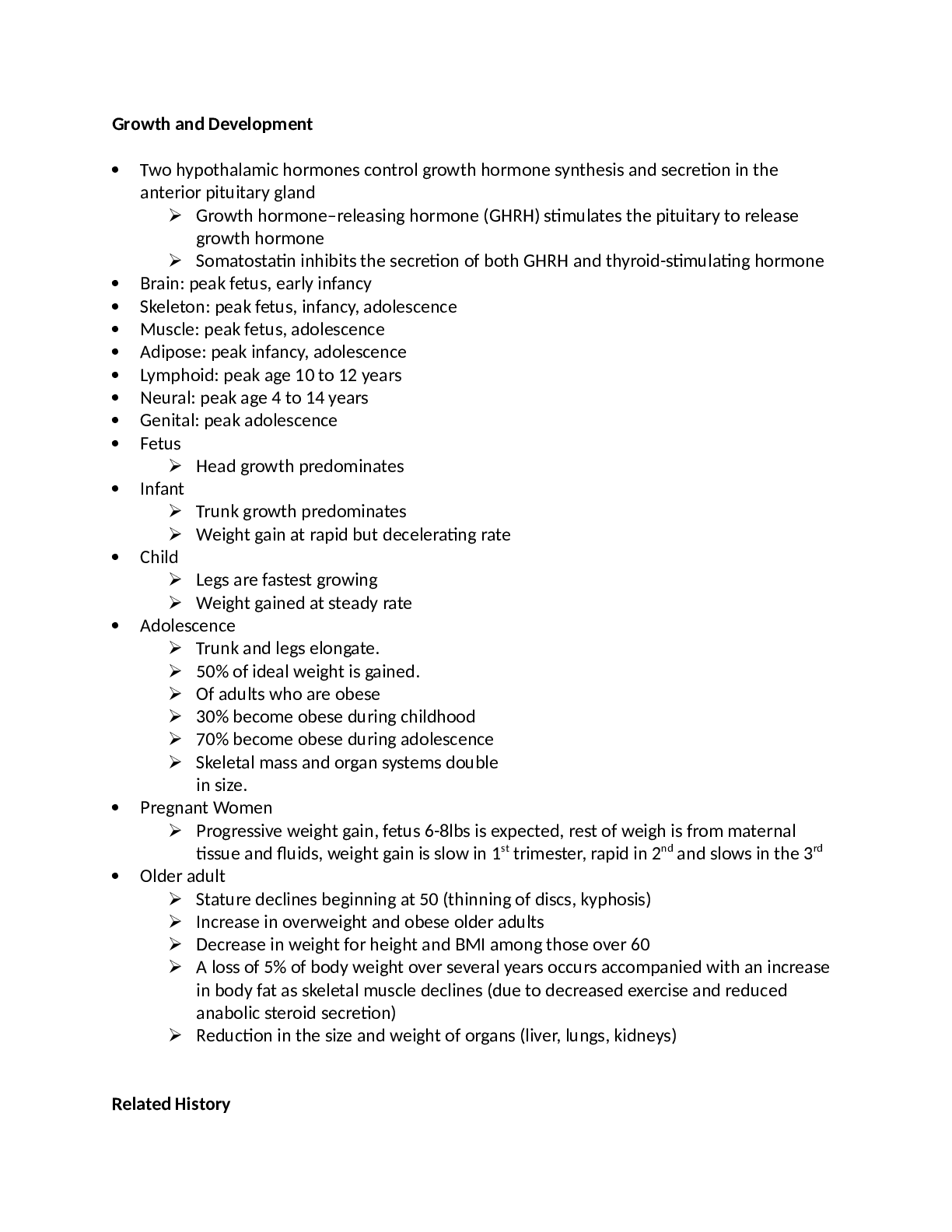
Buy this document to get the full access instantly
Instant Download Access after purchase
Add to cartInstant download
We Accept:

Reviews( 0 )
$22.00
Document information
Connected school, study & course
About the document
Uploaded On
Jul 10, 2021
Number of pages
5
Written in
Additional information
This document has been written for:
Uploaded
Jul 10, 2021
Downloads
0
Views
124

